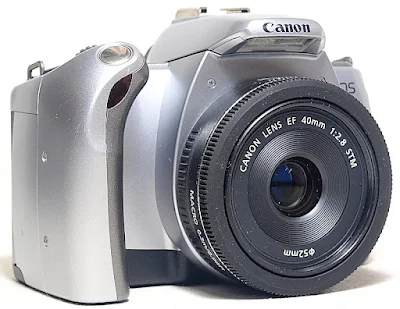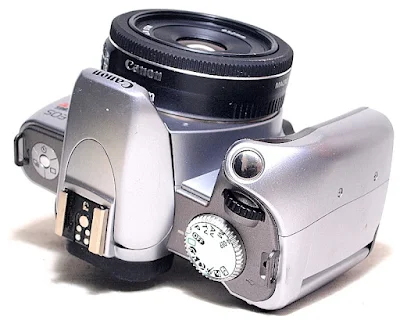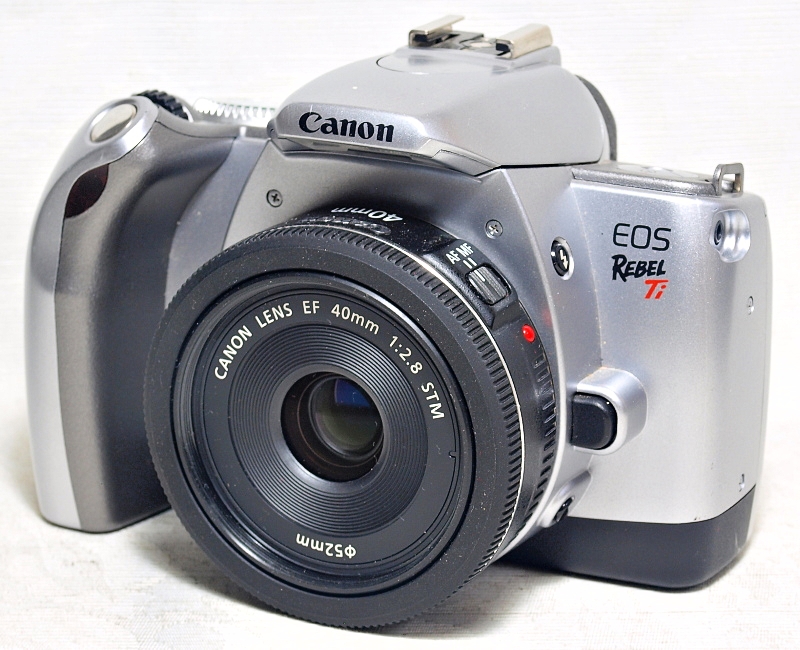The camera, an upgrade to the Rebel 2000 (EOS Rebel 2000 in Europe, Asia, and Asiana, EOS Kiss III in Japan), comes with a 7-point area-wide AF, the fastest AF speed in its class, improved predictive AF performance, and a super slim fit body that weighs only 365 grams.
Other enhancements to the Rebel Ti include an all-new stainless steel lens mount, the most welcomed of all improvements. Changes were also made to the main operating control, now relocated to the right of the camera's top plane, which now can be operated with one hand, A new LCD panel was also introduced, the 30cm square backlighted panel, located on the back of the camera, which by itself, was also given a more ergonomic body design finished in incandescent-silver and metallic-gray.
Technical specifications are consistent with what the Rebel 2000 (EOS 300, EOS Kiss III) has to offer - a built-in retractable camera flash, metal vertical travel focal shutter plane with an electronically controlled speed range from 30 seconds to 1/2000 second in half-stop increments, B, and X-sync at 1/90 second, use of DX-coded 135 film rolls with an ISO speed range from 6-6400, a 10-second delay electronic self-timer, and depth-of-field preview function. Exposure compensation is the same +2 to -2 EV in 1/2 stop increments.
Canon EOS 300v Review - You Need to Buy this film camera! (Rebel Ti)
The Canon EOS 300v is my favorite automatic 35mm SLR made by Canon. It has so much functionality packed into a compact and cheap 35mm film camera body. The Canon EOS 300v might be the best kept secret of film photography. I have been using one for over a year and have taken more photos with it than any other 35mm film camera I own. Lucky for you, they are still cheap and highly available. Also, the autofocus on this camera is legit!
Metering is open-aperture TTL (through the lens) via a 35-zone SPC (silicon photocell) set to an automatic selection between Evaluative (linkable to any AF point), Partial (set automatically with AE Lock), and Center-weighted Averaging (set automatically in Manual mode). Autofocus, with automatic AF sensor light, is TTL-SIR with a CMOS sensor.
Basic Camera Features
The EOS Rebel Ti is also available as a date version. The model stayed in production until it was replaced by the EOS Rebel T2 (EOS 300X in Europe, Asia, and Oceania, EOS Kiss 7 in Japan) in September 2004.
A simple ergonomic front, with a curved hand grip/battery chamber extrusion that also holds the main dial, shutter button on the upper slant of the ledge, with the remote control sensor/lamp cum self-timer light at the front of the extrusion, the lens housing mount, central to the body, with the retractable built-in flash on to of the pentamirror hump.
Located on the upper and lower sections of the vertical of the lens mount are the flash release and depth-of-field preview buttons, with the lens release button midway between the two on the right of the mount, and the remote control terminal on top of the right shoulder. The built-in flash also doubles up as the AF-Assist lamp and Red Eye Reduction lamp.
On the top plane, on the left is the shutter mode selector button, which cycles between single, triple, and self-timer shot settings, a hot shoe on top of the pentamirror hump, and to the right of the top plane, the exposure mode and command dials, and the shutter release on the slant.
On the back, a non-interchangeable hinged back with the square LCD panel amidship, a film indicator window, and the film back release latch to the left of the film back, with the viewfinder eyepiece located at the back of the pentamirror hump just above the film back, and the AE Lock and Exposure Compensation buttons to the top right.
The LCD panel is accompanied by three additional buttons - Exposure Compensation, Function, and LCD Panel Illuminator - aligned vertically to the right, and a (small) midroll rewind button on the lower bottom right of the panel.
On the bottom plane, just the tripod socket and battery chamber cover.
Again, the epitome of efficiency, the film box is autoloading with the film canister chamber on the left of the film box, the shutter window in the middle, and the film spool area to the right.
Film Load and Rewind
Film loading and rewinding are both motorized. The EOS Rebel Ti uses a system where the entire film roll is first wound completely onto the camera's take-up spool, and as the shots are taken, the exposed frames are wound back into the film canister.
This safety system ensures that in the event the film back is opened accidentally, the exposed part of the film, albeit the last frame shot, is safe and has been wound back into the film canister.
Loading film into the camera is simple and straightforward. First, turn the camera power on, open the film back, load the canister in the chamber, pull the film tab across to the pick-up spool area, and align the tab end to the red mark. Make sure that the film is properly tensioned across the opening, close the back, and the automatic function of the camera will take over.
The number of image frames available will be indicated on the LCD panel.
Viewfinder Readout
The 90% coverage eye-level pentamirror viewfinder is fitted with a Laser-matte screen with overlaid focus point indicators, and a lower screen display indicators for shutter speed, aperture, exposure level, AE/FE lock, a flash ready indicator, high-speed sync, red-eye reduction icon, focusing point indicator, and in-focus (both AF and MF).
LCD Panel Display
The LCD Panel (Date Version) display, shown here with all information displayed. The actual display on the camera will only show relevant information based on the camera's functional setting.
Exposure Mode Dial
The Exposure Mode Dial (referred to as the Command Dial in the Instruction Manual) is divided into three zones.
- The upper Creative Zone is for setting the creative aspects of using the camera in Programmed AE (P), Shutter Priority AE (Tv), Aperture Priority AE (Av), Manual Exposure (M), and Automatic Depth-of-Field (A-DEP) modes.
- The Full Auto mode lets the camera take care of everything. All you have to do to point and shoot.
- The lower Image Zone is for setting the camera up in automatic mode for specific subject area photography - Portrait, Landscape, Close-up, Sports, Night Portrait, and Flash Off.
Ease of Use
A simple test. Is the camera easy to use, and does it stand up to its billing that the camera can be used even with one hand? The answer is Yes, it does, definitely.
With the camera held to your eye, in Manual shooting mode for example, where you need to adjust both the shutter speed and lens aperture opening manually, you first adjust the shutter speed setting by turning the dial with your index finger, and next, for adjusting the lens aperture opening, press and hold the AV +/- function button, and again, use the index finger to manipulate the main dial, which now controls the lens aperture opening. Easy as that.
Battery and Camera Body Weight
The EOS Rebel Ti requires a pair of CR2 Lithium cells to power its operation.
The camera's body weight is 365 grams without batteries.
Instruction Manual
The instruction manual for the EOS Rebel Ti / Rebel 300V is available for download from buktus.org.
End Note
For this review, the EOS Rebel Ti was mounted with a Canon EF 40mm 1:2.8 STM. The camera/lens combo now, without the shoulder strap, weighs only 518 grams on the kitchen scale, a true lightweight when compared to, say, a vintage all-metal 35mm SLR film camera with an equally vintage all-metal and glass lens, which may very well tip the scale over 1.2 kg or more.
With the camera in hand, you will be equally spoilt for choice when it comes to the range of lenses available. The EF-mount is the standard for all Canon EOS cameras, film or digital, and picking one that you are going to use for both film and digital SLR cameras is always a wise choice.
























No comments:
Post a Comment